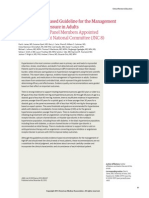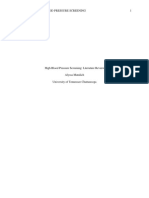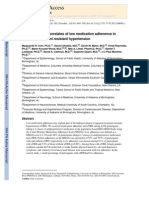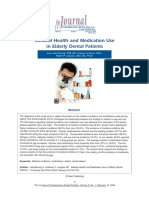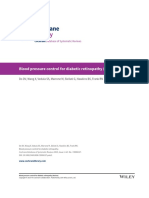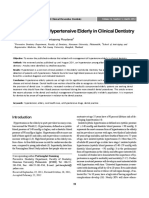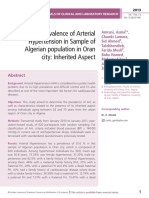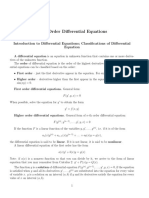Prevalence and Severity of Hyper-Tension in A Dental Hygiene Clinic
Uploaded by
Matthew RyanCopyright:
Available Formats
Prevalence and Severity of Hyper-Tension in A Dental Hygiene Clinic
Uploaded by
Matthew RyanOriginal Description:
Original Title
Copyright
Available Formats
Share this document
Did you find this document useful?
Is this content inappropriate?
Copyright:
Available Formats
Prevalence and Severity of Hyper-Tension in A Dental Hygiene Clinic
Uploaded by
Matthew RyanCopyright:
Available Formats
4
PREVENIE STOMATOLOGIC
PREVALENCE AND SEVERITY OF HYPERTENSION IN A DENTAL HYGIENE CLINIC
Ana Luz Thompson1, RDH, MHE; Marie A. Collins2, RDH, EdD;
Mary Cannon Downey3, RDH, MS; Wayne W. Herman 4, DDS, MS;
Joseph Louis Konzelman Jr.5, DDS; Sue Tucker Ward6, RDH, Med;
Cynthia T. Hughes7, RHD, BSDH, Med
1Assistant
Professor in the Department of Dental Hygiene at the Medical College of
Georgia School of Allied Health Sciences in Augusta, GA, USA
2Chair & Associate Professor in the Department of Dental Hygiene at the Medical
College of Georgia School of Allied Health Sciences in Augusta, GA, USA
3Associate Professor in the Department of Dental Hygiene of the School of Allied
Health Sciences at the Medical College of Georgia in Augusta, GA, USA
4Professor in the Department of Oral Diagnosis of the School of Dentistry at the
Medical College of Georgia in Augusta, GA, USA
5Professor in the Department of Oral Diagnosis of the School of Dentistry at the
Medical College of Georgia in Augusta, GA, USA
6Assistant Professor and Clinic Coordinator in the Department of Dental Hygiene at
the Medical College of Georgia School of Allied Health Sciences in Augusta, GA, USA
7Administrator for CoastDental in Tampa, FL, USA; Dental Hygiene Degree from
the Medical College of Georgia; Master of Education from Cambridge College;
Clinician, Educator, and Speaker
ABSTRACT
Aim: The purpose of this study was to assess the prevalence and severity of hypertension in a dental hygiene clinic and evaluate
factors related to the disease.
Methods and Materials: Records of 615 patients, treated by dental hygiene students during 2003, were reviewed. Data collected
included systolic and diastolic blood pressure, presence of diabetes and renal disease, non-modifiers (race, gender, and age), and
modifiers (marital status, smoking habits, and occupation).
Results: According to the Seventh Report of the Joint National Committee on the Prevention, Detection, Evaluation, and Treatment
of High Blood Pressure (JNC7) classification, 154 (25%) of the subjects had normal blood pressure readings, 374 (60.8%) had
prehypertension, and 87 (14.1%) had stage 1 hypertension. Statistical analysis showed a significant difference in the JNC7
classification between groups when considering the non-modifiers race (p=.02) and the modifiers smoking habits (p=.03) and
occupation (p=.01). A statistically significant difference in the JNC7 classification existed between groups with diabetes (p=.00).
The majority of patients had blood pressure readings in the prehypertension stage.
Conclusion: Based on these results, the researchers recommend clinical policy modifications which include: additional documentation
for blood pressure readings in the prehypertension stage, lowering the systolic reading from 160 mmHg to 140 mmHg when adding
hypertension alert labels, and noting prehypertension/hypertension on the dental hygiene care plan with the appropriate interventions.
Keywords: Hypertension, JNC7 classification, blood pressure, dental hygiene education
REZUMAT
Scopul acestui studiu a fost evaluarea prevalenei i a severitii hipertensiunii ntr-o clinic de igien oral i analiza factorilor
asociai cu aceast boal. Tehnici i materiale: registrele a 615 pacieni tratai de studeni n anul 2003 au fost revzute. Printre
datele analizate s-au numrat tensiunea sistolic i diastolic, prezena diabetului i a bolilor renale, factori constani(ras, gen i
vrst) i factori care se pot modifica(statutul civic, obiceiuri vicioase, fumatul i locul de munc). Rezultate: conform clasificrii
JNC 7 n ceea ce privete prevenirea, depistarea, evaluarea i tratamentul hipertensiunii valorile obinute au fost urmtoarele:
154(25%)din subieni aveau valori normale ale tensiunii, 374(60,8%) aveau valori prehipertensionale i 87(14,1%) aveau
hipertensiune gradul 1. O analiz statistic a evideniat diferene semnificative n funcie de ras, obiceiuri vicioase JNC 7 au
aprut ntre grupurile cu diabet. Majoritatea pacienilor prezentau valori ale tensiunii ce se ncadrau ntr-un stadiu prehipertensional.
Concluzii: pe baza rezultatelor obinute, cercettorii au impus modificri n politica clinicii, modificri printre care se urmresc:
documentaii suplimentare n stadiu prehipertensional, scderea valorii standard a tensiunii sistolice de la 160mmHg la 140 mmHg
i corelarea tratamentului de igien oral cu valorile tensiunii, prin stabilirea tratamentului optim pentru pacient.
Cuvinte cheie: hipertensiune, clasificarea JNC7, presiune sagvin, educaie de igien dentar.
Citation: Thompson AL, Collins MA, Downey MC, Herman WW, Konzelman Jr JL, Ward ST, Hughes CT. Prevalence and
Severity of Hypertension in a Dental Hygiene Clinic. J Contemp Dent Pract 2007 March; (8)3:013-020.
REVISTA ROMN DE STOMATOLOGIE VOL. LIII, NR. 2, AN 2007
89
90
REVISTA R OMN DE STOMATOLOGIE VOL. LIII, NR. 2, A N 2007
INTRODUCTION
Determination of blood pressure for dental and
dental hygiene patients is an essential step in the
assessment phase of care. As a result of various
hypertension studies, it has been emphasized
hypertension is unquestionably a contributing risk
factor in many vascular diseases. Hypertension plays
a significant role in the progression of heart failure,
kidney failure, stroke, and heart attack. (1-3)
According to the Seventh Report of the Joint
National Committee on the Prevention, Detection,
Evaluation, and Treatment of High Blood Pressure
(JNC7), patients are considered hypertensive if their
systolic pressure is equal to or greater than 140
mmHg, if their diastolic pressure is greater than or
equal to 90 mmHg, or if they are presently taking
antihypertensive medications. (1) About one out of
five Americans has hypertension. (4) It is estimated
hypertension precedes the development of
congestive heart failure in 91% of cases. High blood
pressure is associated with a two to three times higher
risk of developing congestive heart failure. (5)
Researchers have indicated the prevalence of
high blood pressure in persons living in the southeast is greater than in any other area of the
country, and African Americans develop high
blood pressure earlier in life and have a higher
average blood pressure than Caucasians. As a
result, African Americans have a higher rate of
stroke, stroke fatalities, heart disease, and endstage kidney disease. (1)
Previously, it was believed once a patients blood
pressure reading was greater than 140/90 mmHg,
the patient was at an increased risk to develop
cardiovascular disease. Recent findings published
in the JNC7 report present a new prehypertension
stage. The JNC7 report suggests individuals with a
systolic blood pressure of 120 to 139 mmHg or a
diastolic blood pressure of 80 to 89 mmHg should
be considered at risk for development of hypertension. Lifestyle modifications to promote health
should be recommended by healthcare providers.(1)
In 1982 the American Dental Hygienists Association endorsed the practice of measuring blood
pressure on all patients. Standards were developed
to include blood pressure as part of the general
health assessment data routinely recorded. (6) In
the late nineties dentists were encouraged to take
a primary role on the multidisciplinary team involved in treating and educating patients at risk
for hypertension. Glick (7) stated professional
duties should not be limited to the provision of
dental care as oral healthcare providers can have
a significant impact on the prevention, detection,
evaluation, and treatment of patients with high
blood pressure. He further challenged dentists to
take a proactive part in the overall healthcare of
their patients. Several investigators have encouraged dental hygienists to routinely monitor
patients blood pressure as a part of total patient
care. (2,6,7) These researchers have recognized
dental hygienists as specialists in prevention with
the education and knowledge necessary to transmit
an appreciation of hypertension control as a lifetime
duty to all their patients.
During the medical history update, dental
caregivers can identify some of the possible
symptoms or signs of hypertension. These include
dizziness, fainting, headaches, shortness of breath,
memory impairment, and disturbances with
concentration. (5) However, because there are
often no symptoms many patients are not aware
of increases in their blood pressure. (1)
The first step in the dental hygiene process of
care is assessment. This assessment includes
gathering pertinent information such as vital signs
(blood pressure, pulse, and tobacco use), examining extra oral and intra oral tissue, and
performing dental and periodontal chartings. This
data is important for the dental hygiene diagnosis.
(3) At this point, the dental hygienist identifies the
patients problems and selects interventions that
will achieve the desired outcomes. During the development of the treatment plan, dental hygienists
must consider the impact the patients medical condition(s) may have on the care they will provide.
There are a few dental complications associated
with hypertension. Patients with severe hypertension have been reported to develop facial palsy
or to bleed excessively after surgical procedures
or trauma, but the occurrence of these complications is rare. Side effects of medications used
to control hypertension include xerostomia,
lichenoid reactions, gingival overgrowth, severe
bleeding, and delayed healing. (8)
Uncontrolled hypertension increases a patients
danger of suffering an episode of angina, myocardial infarction, or stroke while in the dental chair.
(9) During dental hygiene appointments, it may be
necessary to anesthetize the patient for comfort. The
danger in using a local anesthetic containing
epinephrine or other vasoconstrictors on a patient
with hypertension or other cardiovascular disease
is an increase in blood pressure or the development
of an arrhythmia. To prevent serious complications,
it is unwise to perform elective dental procedures
on patients with severe or uncontrolled hypertension. (1,8) In a recent publication Herman et al. (9)
support this intent in the dental practice setting.
They suggest blood pressure readings should be
taken on all new patients and annually on recall
91
REVISTA ROMN DE STOMATOLOGIE VOL. LIII, NR. 2, AN 2007
patients. In addition, they recommend the blood
pressure of patients with documented hypertension
be assessed at each dental visit because failure to
detect severe elevations of blood pressure can result
in stroke or myocardial infarction during complex
dental procedures.
Since the initiation of the Medical College of
Georgia Dental Hygiene program in September
1967, it has been a common practice for dental
hygiene students to record the blood pressure
readings of patients previously diagnosed with
hypertension. This standard of care became a practice
for all adult patients in the mid-seventies. Currently,
dental hygiene students learn essential information
about hypertension and blood pressure determination
during their first semester. They begin applying this
knowledge by taking blood pressure readings on
each other, and in subsequent semesters they record
blood pressure readings on all patients age 16 and
older. The probability of detecting an elevated
reading in a dental hygiene patient is high. To better
identify the hypertensive status of this pool of
patients, it is necessary to investigate the prevalence
and severity of hypertension in the dental hygiene
education environment. It is also essential to study
this particular group to determine if further patient
education or screening measures should be implemented to provide a complete dental hygiene evaluation. An assessment of current practices is crucial.
Dental hygienists have the opportunity to educate
their patients regarding hypertension, especially those
who are at risk. Therefore, the purpose of this study
is to document the prevalence and severity of
hypertension in a dental hygiene clinic.
METHODS AND MATERIALS
The design of this study was a non-experimental
retrospective chart review. Approval was obtained
from the Medical College of Georgia Institutional
Review Board to conduct the study. Patient records
are confidential and were used only for the purposes
stated in this protocol. Only records of adult patients
treated in the Dental Hygiene Clinic in 2003 were
reviewed. This entire accessible population was
included to form a sample size of 615 records.
Blood pressure readings used in the study were
those previously measured by dental hygiene
students during patient care. To measure blood
pressure, students used an aneroid sphygmomanometer and a stethoscope. The manual procedure
for assessing the blood pressure of patients in the
dental hygiene clinic is a reliable and validated
method. It is outlined in the literature by Cline and
Springstead (6) and widely used by healthcare
providers. Utilizing one dental hygiene faculty
member to teach the didactic concepts of blood
pressure determination and interpretation also
enhances the reliability of the blood pressure
assessment by dental hygiene students. Clinical competency in assessing blood pressure is evaluated using
written didactic testing and clinical skill forms.
DATA COLLECTION
A single researcher extracted from patient
records demographic data including race, age,
gender, marital status, and occupation based on
Takashima et al. (10) Medical information was also
collected. This included the most recent systolic
and diastolic blood pressure, diabetes (yes/no),
renal disease (yes/no), smoking habits (yes/no),
and use of antihypertensive medication (yes/no).
Only data from the most recent visit was gathered
in this study since many patients had multiple visits
in 2003.
STATISTICAL ANALYSIS
The level of significance for this study was set
at p <.05. Cross tabulations of JNC7 classification
and categorical modifiers (occupation, marital
status, and smoking habits) and non-modifiers
(race, gender, and age) were performed using
Statistical Package for Social Sciences (SPSS)
Version 10.0 software (SPSS Inc., Chicago, IL,
USA).
RESEARCH QUESTIONS
While the principal research question was
What is the prevalence and severity of hypertension in a dental hygiene clinic?, the goal of
this study was to answer the following research
questions regarding the dental hygiene clinic
policy for the assessment and interpretation of
blood pressure readings according to the recent
JNC7 classification of adult hypertension:
1. What is the prevalence and severity of hypertension in patients treated in the dental
hygiene clinic at the Medical College of
Georgia according to the JNC7 classification?
2. Is there a difference between various nonmodifiers (race, gender, and age) in terms
of JNC7 classification?
3. Is there a difference between various modifiers (marital status, smoking habits, and
occupation) in terms of JNC7 classification?
4. Is there a difference between subject groups
(with/without diabetes and with/without renal
disease) in terms of JNC7 classification?
92
REVISTA R OMN DE STOMATOLOGIE VOL. LIII, NR. 2, A N 2007
5. Is existing dental hygiene clinical policy for
assessing blood pressure and interpreting
blood pressure readings consistent with the
new JNC7 classification?
RESULTS
The study sample was approximately 77% (615/
800) of the patients treated in 2003. Information
from the records of 615 subjects was gathered for
this study. The age of the subjects ranged from 18
to 90 years with a median age of 49.5 and mean
age of 49.4 years, SD = 18.25.
The ethnic composition of the sample was
African American (n=178, 29.6%), Caucasian
(n=380, 63.2%), and a combined group of Asians,
Hispanics, multiracial, and others (n=43, 7.2%).
Fourteen records did not include race, therefore,
they were excluded from the analysis of blood
pressure by race.
Gender representation was 63.1% (388/615)
female and 36.9% (227/615) male. More than half
of the subjects were married (53.1%), 31.8% were
single, 6.5% were divorced, and 5% were widowed.
Table 1 indicates the occupation category of
subjects. The majority of the subjects were nonsmokers (86.3%, 531/615). Smokers comprised
13.7% (84/615) of the subjects. Seventy-three
(11.9%) of the 615 subjects were diabetic and 177
(28.8%) subjects reported use of antihypertensive
medication.
Results indicated the blood pressures of 154
(25%) subjects were optimal, while those of 374
(60.8%) were prehypertensive and 87 (14.1%)
were Stage 1 hypertensive. There were no blood
pressure readings with the Stage 2 hypertension
classification (>160 / >100).
A total of 177 (29%) subjects were taking an
antihypertensive. Of those, 40 (23%) were in the
normal or optimal blood pressure stage and 111
(63%) were in the prehypertensive stage. Even if
being treated for hypertension, these two groups
were considered at goal or controlled in terms of
their readings for that day. The other 26 (14%)
subjects taking medication for hypertension had
readings in Stage 1 of hypertension; therefore,
they were not at goal or controlled for that day.
Results using the chi-square statistic showed
the JNC7 classification did not significantly differ
between subject groups when considering gender
(p=.23) and marital status (p=.25). Results from a
one way analysis of variance (ANOVA) showed
no significant difference in the JNC7 classification
and age (p=.552).
A statistically significant difference in the JNC7
classification was noted between subject groups
when considering the non-modifier, race (p=.02),
as shown in Table 2. More African Americans had
readings at the prehypertension or hypertension
Stage I level.
There was also a statistically significant difference in the JNC7 classification of subjects when
considering the modifiers smoking habits (p=.03)
and occupation (p=.01). Table 3 shows the majority of smokers had prehypertensive or hypertensive Stage I readings. Figure 1 illustrates a
greater number of readings in the prehypertension
and Stage I hypertension of retired subjects, service
Table 2
JNC7 classification and race
Note:a This group was collapsed for statistical analysis and includes subjects who are Hispanic, Asian, multiracial, and races
reported as other in the clinic record.b Result of Chi square analysis reveals the difference between groups is statistically
significant: X2(4, N=601)=11.51, p=0.02.
REVISTA ROMN DE STOMATOLOGIE VOL. LIII, NR. 2, AN 2007
93
Table 3
JNC7 classification and smoking
Note:a Result of Chi square analysis reveals the difference between groups is statistically
significant: X2(2, N=615)=6.8, p=0.03.
personnel, and professional/technology occupations when compared to other occupations.
Figure 1
JNC7 classification and occupation category.
As shown in Table 4, 22 (30%) of the diabetic
subjects were not at goal or controlled and 39
(53.4%) had prehypertensive readings. This
difference was statistically significant (p=.00).
DISCUSSION
Our results closely mirror those published in
the literature which show a significant difference
in hypertension prevalence when considering race,
smoking habits, occupation, and diabetes.
(1,2,5,7-10)
Consistent with the current study, statistics from
the American Heart Association show African
Americans have a higher average blood pressure
than Caucasians.(4) Several authors also agree
current smokers are at risk for systolic
hypertension.(1,9) Unlike Zachariah et al., (11)
the results of the present study found occupations
involving moderate or greater physical activity was
inversely associated with the prevalence of
hypertension. In their study, more sedentary employees like office workers had more hypertension
when compared to more physically active factory
and assembly line workers.
A particularly alarming finding in the current
study shows 30% of diabetic subjects were not at
goal or controlled. Kaplan noted the combination
of diabetes and hypertension adds to cardiovascular and renal damage, placing all diabetic
hypertensives at increased risk for these conditions.(12)
The most recent JNC7 guidelines are
encouraging patients to maintain blood pressure
readings lower than what it was considered normal
a few years ago. The majority of records reviewed
in this study reflected readings no longer
considered normal. Even though the results of this
study cannot be generalized to the entire population, they can be useful when planning modifications to the current dental hygiene clinic
policy on assessing and interpreting blood pressure
readings. The findings of this research project
reiterate what has been proposed by the JNC7 and
other authors who place emphasis on the need of
increasing patients awareness about the dangers
of hypertension.
Table 4
JNC7 classification and diabetes.
Note: Result of Chi square analysis reveals that the difference between groups is statistically
significant: X2(4, N=606)=18.54, p=0.00.
94
REVISTA R OMN DE STOMATOLOGIE VOL. LIII, NR. 2, A N 2007
The diagnosis of hypertension must be made
by a physician, usually after several abnormal
readings are documented. However, dental hygiene students are in a unique position to assess
blood pressure and increase the patients
awareness of the potential risks associated with
hypertension including obesity, smoking, and a
sedentary lifestyle.
Most encounters with allied health professionals occur when patients are ill or undergoing
diagnostic procedures, but since a systemic illness
is not the reason for seeking dental hygiene care
many patients consider themselves healthy during
their dental visits. It is common for dental hygienists to treat medically compromised patients.
In contrast to other allied healthcare professionals
dental hygienists have regular contact with patients
due to frequent care intervals. For that reason,
dental hygienists have an exceptional opportunity
to monitor blood pressure. Communication concerning high readings and appropriate patient education may motivate patients to seek the care of
their physicians.
CONCLUSION
Based on the results of this study, the researchers suggest clinical policy modifications including: additional documentation for blood pressure
readings in the prehypertension stage, lowering
the systolic readings from 160 mmHg to 140
mmHg when adding hypertension alert labels, and
documenting prehypertension/hypertension on the
dental hygiene care plan with the appropriate
intervention such as medical consultation prior to
dental and dental hygiene treatment.
REFERENCES
1.
2.
3.
4.
5.
6.
Chobanian AV, Bakris GL, Black HR, Cushman WC, Green
LA, Izzo Jr. JL, Jones DW, Materson BJ, Oparil S, Wright Jr.
JT, Rocella EJ, and the National High Blood Pressure Education
Program Coordinating Committee. JNC7-Complete Version.
Seventh Report of the Joint National Committee on Prevention,
Detection, Evaluation, and Treatment of High Blood Pressure.
Hypertension 2003;42:1206-52.
Hughes CT, Thompson AL, Browning WD. Blood pressure
screening practices of a group of dental hygienists. J Dent Hygiene
2004;78(4).
Wyche CJ. The dental hygiene care plan. In E.M. Wilkins Clinical
practice of the dental hygienist. Ninth ed. Philadelphia: Lippincott
Williams & Wilkins, 2005:351-61.
American Heart Association. Heart disease and stroke statistics:
2003 update. Dallas.
Levy D, Larson MG, Vasan RS, Kannel WB, Ho KK. The
progression from hypertension to congestive heart failure. [comment]
J Am Med Assoc 1996;275(20):1557-62.
Cline NV, Springstead MC. Monitoring blood pressure. Five
minutes critical to quality patient care. J Dent Hygiene
1992;66(8):363-8.
7.
Glick M. New guidelines for prevention, detection, evaluation and
treatment of high blood pressure. J Am Dent Assoc
1998;129(11):1588-94.
8. Little JW, Falace DA, Miller CS, Rhodus NL. Dental
management of the medically compromised patient. 6th Edition, St.
Louis: Mosby, 2002.
9. Herman WW, Konzelman JL, Prisant LM. New national
guidelines on hypertension. A summary for dentistry. J Am Dent
Assoc 2004;135:576-84.
10. Takashima Y, Yoshida M, Kokase A, Orido Y, Tsugane S,
Ishikawa M, Takeuchi Y, Takagi Y, Tanaka N, Watanabe S,
Akamatsu T. Relationship of occupation to blood pressure among
middle-aged Japanese men- the significance of the differences in
body mass index and alcohol consumption. J Epidemiol, 1998; 8(4),
216-226.
11. Zachariah MG, Thankappan KR, Alex SC, Sarma PS, Vasan,
RS. Prevalence correlates, awareness, treatment, and control of
hypertension in a middle-aged urban population in Kerala. Indian
Heart J, 2003; 55(3) 245-251.
12. Kaplan NM. Hypertension and diabetes. J Hum Hypertens,
2002;16, Suppl. 1, 56-60.
Article published in THE JOURNAL OF CONTEMPORARY DENTAL PRACTICE, vol. 8, nr. 3, March 1, 2007 at www.thejcdp.com. Reprinted with
permission of Publisher.
You might also like
- 2014 Evidence-Based Guideline For The Management of High Blood Pressure in AdultsNo ratings yet2014 Evidence-Based Guideline For The Management of High Blood Pressure in Adults41 pages
- Effect On Blood Pressure of A Continued Nursing Intervention Using Chronotherapeutics For Adult Chinese Hypertensive PatientsNo ratings yetEffect On Blood Pressure of A Continued Nursing Intervention Using Chronotherapeutics For Adult Chinese Hypertensive Patients9 pages
- Risk Factors For Hypertension and Its Complications Case Control StudyNo ratings yetRisk Factors For Hypertension and Its Complications Case Control Study4 pages
- Assessment of Overweight and High Blood Pressure Among Individuals in Out - Patient Clinic in A Specialist HospitalNo ratings yetAssessment of Overweight and High Blood Pressure Among Individuals in Out - Patient Clinic in A Specialist Hospital3 pages
- Running Head: High Blood Pressure Screening 1No ratings yetRunning Head: High Blood Pressure Screening 113 pages
- Evaluation of Diabetic Foot Management iNo ratings yetEvaluation of Diabetic Foot Management i7 pages
- Effects of Comprehensive Lifestyle Modification On Blood Pressure Control Main Results of The PREMIER Clinical TrialNo ratings yetEffects of Comprehensive Lifestyle Modification On Blood Pressure Control Main Results of The PREMIER Clinical Trial16 pages
- Dental Management in Patients With HypertentionNo ratings yetDental Management in Patients With Hypertention10 pages
- Knowledge and Perceptions Related To Hypertension, Lifestyle Behavior Modifications and Challenges That Facing Hypertensive PatientsNo ratings yetKnowledge and Perceptions Related To Hypertension, Lifestyle Behavior Modifications and Challenges That Facing Hypertensive Patients12 pages
- Relationship Between Knowledge and Family Support Regarding Hypertension With Blood Pressure Control in ElderlyNo ratings yetRelationship Between Knowledge and Family Support Regarding Hypertension With Blood Pressure Control in Elderly9 pages
- Literature Review On Hypertension in Nigeria100% (2)Literature Review On Hypertension in Nigeria5 pages
- Persepsi Penderita Hipertensi Terhadap Kepatuhan DietNo ratings yetPersepsi Penderita Hipertensi Terhadap Kepatuhan Diet10 pages
- TOBIAS - Nursing Process Paper Fall 2011 - FINAL GRADED Corrections RevBNo ratings yetTOBIAS - Nursing Process Paper Fall 2011 - FINAL GRADED Corrections RevB14 pages
- Hypertension Profile in An Adult Dental PopulationNo ratings yetHypertension Profile in An Adult Dental Population7 pages
- Running Head: Improving Care For Patients With HypertensionNo ratings yetRunning Head: Improving Care For Patients With Hypertension6 pages
- Blood Pressure Control For Diabetic Retinopathy (Review) : CochraneNo ratings yetBlood Pressure Control For Diabetic Retinopathy (Review) : Cochrane4 pages
- Management of Hypertensive Elderly in Clinical Dentistry: Patcharaphol Samnieng, Kantapong PloydanaiNo ratings yetManagement of Hypertensive Elderly in Clinical Dentistry: Patcharaphol Samnieng, Kantapong Ploydanai9 pages
- A Riview of Nutritional Factor in Hypertension Management100% (1)A Riview of Nutritional Factor in Hypertension Management13 pages
- Limited-evidence-suggests-no-difference-in-implantNo ratings yetLimited-evidence-suggests-no-difference-in-implant3 pages
- 9 - Dental Treatment For High-Risk Patients With Refractory Heart Failure A Retrospective Observational Comparison StudyNo ratings yet9 - Dental Treatment For High-Risk Patients With Refractory Heart Failure A Retrospective Observational Comparison Study10 pages
- Hypertension Knowledge, Attitude, and Practice in Adult Hypertensive Patients at A Tertiary Care Hospital in Sri LankaNo ratings yetHypertension Knowledge, Attitude, and Practice in Adult Hypertensive Patients at A Tertiary Care Hospital in Sri Lanka11 pages
- Smoking and Blood Sugar Level: An Important Cause of Cardiovascular Diseases Among AustraliansNo ratings yetSmoking and Blood Sugar Level: An Important Cause of Cardiovascular Diseases Among Australians11 pages
- High Blood Pressure and The Measures To Prevent Cardiovascular Disease of HypertensionNo ratings yetHigh Blood Pressure and The Measures To Prevent Cardiovascular Disease of Hypertension4 pages
- Dose-Response Association of Uncontrolled Blood Pressure and Cardiovascular Disease Risk Factors With Hyperuricemia and GoutNo ratings yetDose-Response Association of Uncontrolled Blood Pressure and Cardiovascular Disease Risk Factors With Hyperuricemia and Gout8 pages
- Management of Inpatient Elevated Blood PressuresNo ratings yetManagement of Inpatient Elevated Blood Pressures11 pages
- Complementary and Alternative Medical Lab Testing Part 4: VascularFrom EverandComplementary and Alternative Medical Lab Testing Part 4: VascularNo ratings yet
- Complementary and Alternative Medical Lab Testing Part 3: CardiologyFrom EverandComplementary and Alternative Medical Lab Testing Part 3: Cardiology1/5 (1)
- Diabetes Risks from Prescription and Nonprescription Drugs: Mechanisms and Approaches to Risk ReductionFrom EverandDiabetes Risks from Prescription and Nonprescription Drugs: Mechanisms and Approaches to Risk ReductionNo ratings yet
- Complementary and Alternative Medical Lab Testing Part 11: MenFrom EverandComplementary and Alternative Medical Lab Testing Part 11: MenNo ratings yet
- Improving Outcomes in Chronic Obstructive Pulmonary Disease: Optimizing Maintenance Therapy Across Health Care SettingsFrom EverandImproving Outcomes in Chronic Obstructive Pulmonary Disease: Optimizing Maintenance Therapy Across Health Care SettingsNo ratings yet
- 2016-2017 COURSE SYLLABUS: Grady High SchoolNo ratings yet2016-2017 COURSE SYLLABUS: Grady High School4 pages
- Sign-Patrick - Laporan Final Studi Ekskursi Fisika XI MIPA 6-SignedNo ratings yetSign-Patrick - Laporan Final Studi Ekskursi Fisika XI MIPA 6-Signed31 pages
- CAPTAIN NOBODY FORM 5 NOVEL Chapters 18-19 PDF100% (1)CAPTAIN NOBODY FORM 5 NOVEL Chapters 18-19 PDF8 pages
- Thermodynamics - II: Clausius-Clapeyron EquationNo ratings yetThermodynamics - II: Clausius-Clapeyron Equation12 pages
- 商業統計bbs14ege ch02 Organizing and Visualizing VariablesNo ratings yet商業統計bbs14ege ch02 Organizing and Visualizing Variables85 pages
- Supreme Court Judgment On Minimum Marks For Selection of District JudgesNo ratings yetSupreme Court Judgment On Minimum Marks For Selection of District Judges35 pages
- Health Problem Family Nusing Problem Goals of Care Objectives of CareNo ratings yetHealth Problem Family Nusing Problem Goals of Care Objectives of Care8 pages
- Transvision - Paket Premium Platinum 2021No ratings yetTransvision - Paket Premium Platinum 20212 pages
- Greek Sanctuaries and Temple Architecture An Introduction 2nd Edition Mary Emerson download pdf100% (4)Greek Sanctuaries and Temple Architecture An Introduction 2nd Edition Mary Emerson download pdf40 pages
- Moran Cruz Jo A. A Cultural History of Education in The Medieval AgeNo ratings yetMoran Cruz Jo A. A Cultural History of Education in The Medieval Age273 pages
- 2014 Evidence-Based Guideline For The Management of High Blood Pressure in Adults2014 Evidence-Based Guideline For The Management of High Blood Pressure in Adults
- Effect On Blood Pressure of A Continued Nursing Intervention Using Chronotherapeutics For Adult Chinese Hypertensive PatientsEffect On Blood Pressure of A Continued Nursing Intervention Using Chronotherapeutics For Adult Chinese Hypertensive Patients
- Risk Factors For Hypertension and Its Complications Case Control StudyRisk Factors For Hypertension and Its Complications Case Control Study
- Assessment of Overweight and High Blood Pressure Among Individuals in Out - Patient Clinic in A Specialist HospitalAssessment of Overweight and High Blood Pressure Among Individuals in Out - Patient Clinic in A Specialist Hospital
- Effects of Comprehensive Lifestyle Modification On Blood Pressure Control Main Results of The PREMIER Clinical TrialEffects of Comprehensive Lifestyle Modification On Blood Pressure Control Main Results of The PREMIER Clinical Trial
- Knowledge and Perceptions Related To Hypertension, Lifestyle Behavior Modifications and Challenges That Facing Hypertensive PatientsKnowledge and Perceptions Related To Hypertension, Lifestyle Behavior Modifications and Challenges That Facing Hypertensive Patients
- Relationship Between Knowledge and Family Support Regarding Hypertension With Blood Pressure Control in ElderlyRelationship Between Knowledge and Family Support Regarding Hypertension With Blood Pressure Control in Elderly
- Persepsi Penderita Hipertensi Terhadap Kepatuhan DietPersepsi Penderita Hipertensi Terhadap Kepatuhan Diet
- TOBIAS - Nursing Process Paper Fall 2011 - FINAL GRADED Corrections RevBTOBIAS - Nursing Process Paper Fall 2011 - FINAL GRADED Corrections RevB
- Hypertension Profile in An Adult Dental PopulationHypertension Profile in An Adult Dental Population
- Running Head: Improving Care For Patients With HypertensionRunning Head: Improving Care For Patients With Hypertension
- Blood Pressure Control For Diabetic Retinopathy (Review) : CochraneBlood Pressure Control For Diabetic Retinopathy (Review) : Cochrane
- Management of Hypertensive Elderly in Clinical Dentistry: Patcharaphol Samnieng, Kantapong PloydanaiManagement of Hypertensive Elderly in Clinical Dentistry: Patcharaphol Samnieng, Kantapong Ploydanai
- A Riview of Nutritional Factor in Hypertension ManagementA Riview of Nutritional Factor in Hypertension Management
- Limited-evidence-suggests-no-difference-in-implantLimited-evidence-suggests-no-difference-in-implant
- 9 - Dental Treatment For High-Risk Patients With Refractory Heart Failure A Retrospective Observational Comparison Study9 - Dental Treatment For High-Risk Patients With Refractory Heart Failure A Retrospective Observational Comparison Study
- Hypertension Knowledge, Attitude, and Practice in Adult Hypertensive Patients at A Tertiary Care Hospital in Sri LankaHypertension Knowledge, Attitude, and Practice in Adult Hypertensive Patients at A Tertiary Care Hospital in Sri Lanka
- Smoking and Blood Sugar Level: An Important Cause of Cardiovascular Diseases Among AustraliansSmoking and Blood Sugar Level: An Important Cause of Cardiovascular Diseases Among Australians
- High Blood Pressure and The Measures To Prevent Cardiovascular Disease of HypertensionHigh Blood Pressure and The Measures To Prevent Cardiovascular Disease of Hypertension
- Dose-Response Association of Uncontrolled Blood Pressure and Cardiovascular Disease Risk Factors With Hyperuricemia and GoutDose-Response Association of Uncontrolled Blood Pressure and Cardiovascular Disease Risk Factors With Hyperuricemia and Gout
- Complementary and Alternative Medical Lab Testing Part 4: VascularFrom EverandComplementary and Alternative Medical Lab Testing Part 4: Vascular
- Complementary and Alternative Medical Lab Testing Part 3: CardiologyFrom EverandComplementary and Alternative Medical Lab Testing Part 3: Cardiology
- Diabetes Risks from Prescription and Nonprescription Drugs: Mechanisms and Approaches to Risk ReductionFrom EverandDiabetes Risks from Prescription and Nonprescription Drugs: Mechanisms and Approaches to Risk Reduction
- Complementary and Alternative Medical Lab Testing Part 11: MenFrom EverandComplementary and Alternative Medical Lab Testing Part 11: Men
- Successful Periodontal Therapy: A Non-Surgical ApproachFrom EverandSuccessful Periodontal Therapy: A Non-Surgical Approach
- Improving Outcomes in Chronic Obstructive Pulmonary Disease: Optimizing Maintenance Therapy Across Health Care SettingsFrom EverandImproving Outcomes in Chronic Obstructive Pulmonary Disease: Optimizing Maintenance Therapy Across Health Care Settings
- Sign-Patrick - Laporan Final Studi Ekskursi Fisika XI MIPA 6-SignedSign-Patrick - Laporan Final Studi Ekskursi Fisika XI MIPA 6-Signed
- 商業統計bbs14ege ch02 Organizing and Visualizing Variables商業統計bbs14ege ch02 Organizing and Visualizing Variables
- Supreme Court Judgment On Minimum Marks For Selection of District JudgesSupreme Court Judgment On Minimum Marks For Selection of District Judges
- Health Problem Family Nusing Problem Goals of Care Objectives of CareHealth Problem Family Nusing Problem Goals of Care Objectives of Care
- Greek Sanctuaries and Temple Architecture An Introduction 2nd Edition Mary Emerson download pdfGreek Sanctuaries and Temple Architecture An Introduction 2nd Edition Mary Emerson download pdf
- Moran Cruz Jo A. A Cultural History of Education in The Medieval AgeMoran Cruz Jo A. A Cultural History of Education in The Medieval Age






